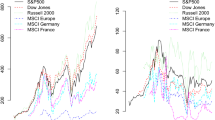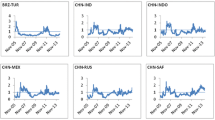Abstract
This paper uses the momentum threshold autoregressive (MTAR) model and the residuals-augmented Dickey–Fuller (RADF) test to examine the possibility of Evans’ (1991) periodically collapsing bubbles in the equity REIT market. The results are mixed. The MTAR model indicates that overall real equity REIT prices and dividends are cointegrated with asymmetric adjustment towards the long-run equilibrium. However, the estimated coefficients of the MTAR model do not indicate the presence of periodically collapsing bubbles. Adjustment in the standard cointegration tests of bubbles for skewness and excess kurtosis via the RADF test fails to reject the null hypothesis of no cointegration, leaving the possibility of periodically collapsing bubbles. The MTAR and RADF results with respect to equity REIT sub-sectors are mixed. Lodging is the only sub-sector in which both the MTAR and RADF results support periodically collapsing bubbles. Moreover, market fundamentals proxied by two alternative measures of capacity utilization do not explain either real equity REIT prices or dividends.
Similar content being viewed by others
References
Abraham, J., & Hendershott, P. H.(1996). Bubbles in metropolitan housing markets. Journal of Housing Research, 7, 191–207.
Below, S. D., Kiely, J. K., & McIntosh, W. (1996). REIT pricing efficiency: Should investors still be concerned? Journal of Real Estate Research, 12(3), 397–412.
Bjorklund, K., & Soderberg, B. (1999). Property cycles, speculative bubbles and the gross income multiplier. Journal of Real Estate Research, 18(1), 151–174.
Bohl, M. T. (2003). Periodically collapsing bubbles in the US stock market? International Review of Economics and Finance, 12, 385–397.
Camerer, C. (1989). Bubbles and fads in asset prices. Journal of Economic Surveys, 3(1), 3–42.
Capelle-Blancard, G., & Raymond, H. (2004). Empirical evidence in periodically collapsing stock price bubbles. Applied Economics Letters, 11, 61–69.
Case, K. G., & Shiller, R. J. (1990). Forecasting prices and excess returns in the housing market. AREUEA Journal, 18, 253–273.
Chan, K. S. (1993). Consistency and limiting distribution of the least squares estimator of a threshold autoregressive model. Annals of Statistics, 21(1), 520–533.
Chan, S. H., Erickson, J., & Wang, K. (2003). Real estate investment trusts: Structure, performance, and investment opportunities. Oxford University Press.
Chan, S. H., Lering, W. K., & Wang, K. (1998). Institutional investment in REITs: Evidence and implications. Journal of Real Estate Research, 16, 357–374.
Charemza, W. W., & Deadman, D. F. (1995). Speculative bubbles with stochastic explosive roots: The failure of unit root testing. Journal of Empirical Finance, 2, 153–163.
Chui, C. W. A., Titman, S., & Wei, K. C. J. (2003). Intra-industry momentum: The case of REITs. Journal of Financial Markets, 6, 363–387.
Clayton, J. (1997). Are housing price cycles driven by irrational expectations? Journal of Real Estate Finance and Economics, 14(3), 341–363.
Damodaran, A., John, K., & Liu, C. H. (1997). The determinants of organization form changes: Evidence and implications from real estate. Journal of Financial Economics, 45, 169–192.
Damodaran, A., & Liu, C. H. (1993). Insider trading as a signal of private information. Review of Financial Studies, 6, 79–120.
Dezbaksh, H., & Demirguc-Kunt, A. (1990). On the presence of speculative bubbles in stock prices. Journal of Financial and Quantitative Analysis, 25(1), 101–112.
Diba, B. T., & Grossman, H. I. (1984). Rational bubbles in the price of gold. NBER Working Paper No. 1300.
Diba, B. T., & Grossman, H. I. (1988a). Explosive rational bubbles in stock prices? American Economic Review, 78, 520–530.
Diba, B. T., & Grossman, H. I. (1988b). The theory of rational bubbles in stock prices. Economic Journal, 98(392), 746–754.
Dickey, D., & Fuller, W. A. (1979). Distribution of the estimators for autoregressive time series with a unit root. Journal of the American Statistical Association, 74, 427–431.
Enders, W., & Granger, C. W. J. (1998). Unit root tests and asymmetric adjustment with an example using the term structure of interest rates. Journal of Business and Economic Statistics, 16(3), 304–311.
Enders, W., & Siklos, P. (2001). Cointegration and threshold adjustment. Journal of Business and Economic Statistics, 19(2), 166–176.
Engle, R., & Granger, C. W. J. (1987). Co-integration and error-correction: Representation, estimation and testing. Econometrica, 55, 251–276.
Evans, G. W. (1991). Pitfalls in testing for explosive bubbles in asset prices. American Economic Review, 81, 922–930.
Gentry, W. M., Kemsley, D., & Meyer, C. J. (2003). Dividend taxes and share prices: Evidence from real estate investment trusts. Journal of Finance, 58, 261–282.
Ghosh, C., Sirmans, C. F., & Nag, R. (2000). The pricing of seasoned equity offerings: Evidence from REITs. Real Estate Economics, 28(3), 363–384.
Glascock, J. L., Lu, C., & So, R. W. (2000). Further evidence on the integration of REIT, bond, and stock returns. Journal of Real Estate Finance and Economics, 20(2), 177–194.
Grenadier, S. (1995). The persistence of real estate cycles. Journal of Real Estate Finance and Economics, 10, 95–119.
Hakkio, C. S., & Rush, M. (1991). Cointegration: How short is the long-run? Journal of International Money and Finance, 10, 571–581.
Harman, Y. S., & Zuehlke, T. W. (2004). Duration dependence testing for speculative bubbles. Journal of Economics and Finance, 28(2), 147–154.
Hendershott, P. H. (2000). Property asset bubbles: Evidence from the Sydney office market. Journal of Real Estate Finance and Economics, 20(1), 67–81.
Howe, J. S., & Shilling, J. D. (1988). Capital structure theory and REIT security offerings. Journal of Finance, 43(4), 983–993.
Im, K. S. (1996). A least squares approach to non-normal disturbances. Working Paper 9603, Department of Applied Economics, University of Cambridge.
Jirasakuldech, B., Campbell, R. D., & Knight, J. R. (2006). Are there rational speculative bubbles in REITs? Journal of Real Estate Finance and Economics, 32(2), 105–127.
Johansen, S. (1995). Likelihood-based inference in cointegrated vector autoregressive models. New York: Oxford University Press.
Johansen, S., & Juselius, K. (1990). Maximum likelihood estimation and inference on cointegration with applications to the demand for money. Oxford Bulletin of Economics and Statistics, 52, 160–210.
Kim, K. H., & Shuh, S. H. (1993). Speculation and price bubbles in the Korean and Japanese real estate markets. Journal of Real Estate Finance and Economics, 6, 73–87.
Kremers, J. J. M., Ericsson, N. L., & Dolado, J. (1992). The power of cointegration tests. Journal of Econometrics, 52, 389–402.
Li, Y., & Wang, K. (1995). The predictability of REIT returns and market segmentation. Journal of Real Estate Research, 10(4), 471–482.
Li, D. D., & Yung, K. (2004). Short interest in real estate investment trusts. University of Maryland Eastern Short and Old Dominion University Working Paper.
Ling, D. C., & Naranjo, A. (1999). The integration of commercial real estate markets and stock markets. Real Estate Economics, 27(3), 483–515.
Ling, D. C., & Ryngaert, M. (1997). Valuation uncertainty, institutional involvement, and the underpricing of IPOs: The case of REITs. Journal of Financial Economics, 43(3), 433–456.
McCallum, B. T. (1983). On non-uniqueness in rational expectations models: An attempt at perspective. Journal of Monetary Economics, 11, 139–168.
McCallum, B. T. (1997). The role of the minimum state variables criterion in rational expectations models. International Journal of Tax and Finance, 6(4), 621–639.
Myer, F. C. N., & Webb, J. R. (1993). Return properties of equity REITs, common stocks, and commercial real estate: A comparison. Journal of Real Estate Research, 8(1), 87–106.
Okunev, J., & Wilson, P. J. (1997). Using nonlinear tests to examine integration between real estate and stock markets. Real Estate Economics, 25(3), 487–503.
Okunev, J., Wilson, P. J., & Zurbruegg, R. (2000). The causal relationship between real estate and stock markets. Journal of Real Estate Finance and Economics, 21(3), 251–261.
Osterwald-Lenum, M. (1992). A note with quantiles of the asymptotic distribution of the maximum likelihood cointegration rank test statistics. Oxford Bulletin of Economics and Statistics, 54, 461–472.
Payne, J. E., & Waters, G. A. (2005). REIT Markets: Periodically collapsing negative bubbles? Applied Financial Economics Letters, 1(2), 65–69.
Perron, P. (1989). The great crash, the oil price shock, and the unit root hypothesis. Econometrica, 57(6), 1361–1401.
Peterson, J. D., & Hsieh, C. (1997). Do common risk factors in the returns on stocks and bonds explain returns on REITs? Real Estate Economics, 25(2), 321–345.
Phillips, P., & Perron, P. (1988). Testing for a unit root in time series regression. Biometrika, 75, 335–346.
Roche, M. J., & McQinn, K. (2001). Testing for speculation in agricultural land in Ireland. European Review of Agricultural Economics, 28(2), 95–115.
Sarno, L., & Taylor, M. P. (1999). Moral hazard, asset price bubbles, capital flows, and the East-Asian crisis: The first tests. Journal of International Money and Finance,18, 637–657.
Sarno, L., & Taylor, M. P. (2003). An empirical investigation of asset price bubbles in latin American emerging financial markets. Applied Financial Economics, 13, 635–643.
Taylor, M. P., & Peel, D. A. (1998). Periodically collapsing stock price bubbles: A robust test. Economics Letters, 61, 221–228.
Topol, R. (1991). Bubbles and volatility of stock prices: Effect of mimetic contagion. Economic Journal, 101(407), 786–800.
Wang, K., Erickson, J., Gau, G., & Chan, S. H. (1995). Market microstructure and real estate returns. Real Estate Economics, 23(1), 85–100.
Author information
Authors and Affiliations
Corresponding author
Rights and permissions
About this article
Cite this article
Payne, J.E., Waters, G.A. Have Equity REITs Experienced Periodically Collapsing Bubbles?. J Real Estate Finan Econ 34, 207–224 (2007). https://doi.org/10.1007/s11146-007-9007-0
Published:
Issue Date:
DOI: https://doi.org/10.1007/s11146-007-9007-0




